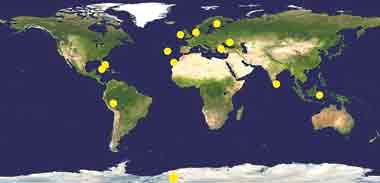
That elusive AtlantisThe possibility that a highly advanced civilisation emerged and then disappeared into the depths of the ocean has captured the imagination of people over the centuries. The story of Atlantis has been the subject of countless books, films and television programmes. Archaeologists excavating in the island of Crete are confident they have found the ruins of the legendary lost continent of Atlantis.
Others claim the fabled palace of Atlantis is at the site of Knossos, the ancient capital of the Minoan civilisation. This palace was three storeys high, with 1,300 rooms and circular waterways surrounding the palace. Excavations reveal a highly developed civilisation that enjoyed multi-levelled homes with toilet and drainage facilities. The story of the lost continent of Atlantis starts in 355 BC, with Plato’s book Timaeus. He describes the splendour of Atlantis and how Atlantis was destroyed. Plato had come to know about Atlantis from Solon, a Greek philosopher from Athens. During a visit to Egypt, Solon was given a detailed account of the Atlantian civilisation and its destruction by Egyptian priests. The Egyptians knew about the devastation of Atlantis, about 1,000 years before Plato heard about it. Hieroglyphic writings in Egypt describe the catastrophic destruction of Atlantis. Crete, a popular tourist destination, is an island in the Mediterranean Sea, close to Greece. Before the Greeks occupied Greece, a fully developed civilisation existed in Crete. When this civilization originated is not known. The Cretan civilization was also known as the Minoan civilization, named after the legendary king Minos. Crete’s capital city was Knossos. It is not known where the original Minoans came from. Some historians believe they came from Asia Minor, while others think they came from the Eastern Mediterranean. The Minoans mastered the sea, which became the basis of their civilization.
The Minoans had a very powerful navy. They traded with Egypt, Spain, North Africa and other countries. Minoan pottery has been found in many countries, especially Egypt. The Minoan economy prospered, its architecture and engineering skills reached new heights, and its fresco paintings excited the admiration of all who saw them. Palaces, temples and buildings excavated so far bear testimony to this high level of achievement. The capital Knossos and other cities, with their palaces and temples, were repeatedly destroyed by earthquakes, and then rebuilt. What we see today are the reconstructed palaces and buildings. The structures were made mainly of limestone, with a timber framework, to minimise the impact of earthquakes. The walls were plastered and decorated with beautifully coloured frescoes, and the floors were paved with slabs of alabaster. The drainage system was highly advnced. This great civilization came to an abrupt end following a massive volcanic eruption, followed by earthquakes and multiple tsunami waves. Scientists say the volcanic eruption occurred on an island called Thera, now called the island of Santorini, situated close to Crete. Most of present-day Crete was submerged and volcanic ash covered the island. The survivors left the island. Probably most of them migrated to Egypt, to tell the tale to their main trading partner. The Egyptians wrote all this down in hieroglyphics for future generations. In 1883, a massive volcanic eruption occurred in Krakatoa, an island close to Indonesia. The eruption was followed by earthquakes and multiple tsunami waves, which killed more than 36,000 people in Java and Sumatra. The sound of the eruption was heard 3,000 miles away. The volcanic eruption at Thera was said to have been four times greater than the one on Krakatoa. Historians and archaeologists continue to debate the site of the lost continent of Atlantis. Some believe Atlantis was just a legend and a story written by Plato. Some think pyramid building originated in Atlantis and spread to Egypt, South America and Mesopotamia. It could be that the Minoan civilisation and the Atlantian civilization are one and the same, and that the lost continent of Atlantis was most likely the island of Crete, which may have been many times the size of present-day Crete. |
|
||||||
|| Front
Page | News | Editorial | Columns | Sports | Plus | Financial
Times | International | Mirror | TV
Times | Funday
Times || |
| |
Reproduction of articles permitted when used without any alterations to contents and a link to the source page.
|
© Copyright
2008 | Wijeya
Newspapers Ltd.Colombo. Sri Lanka. All Rights Reserved. |

